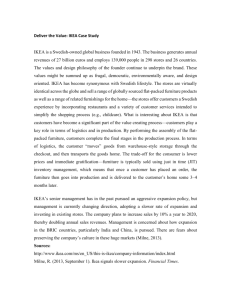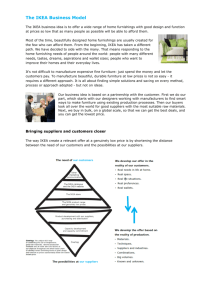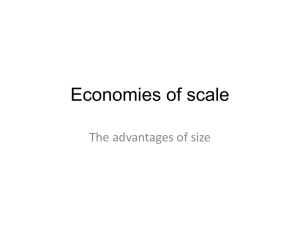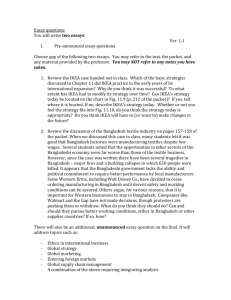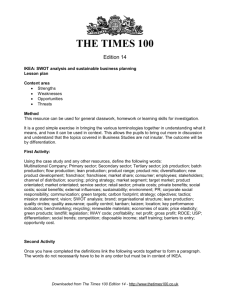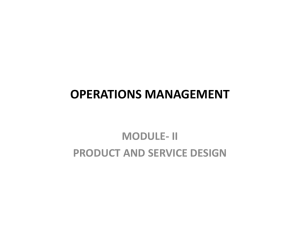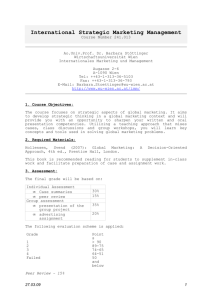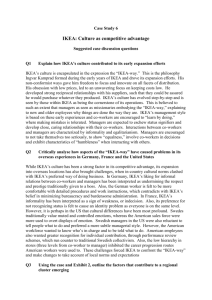Ikea:
advertisement
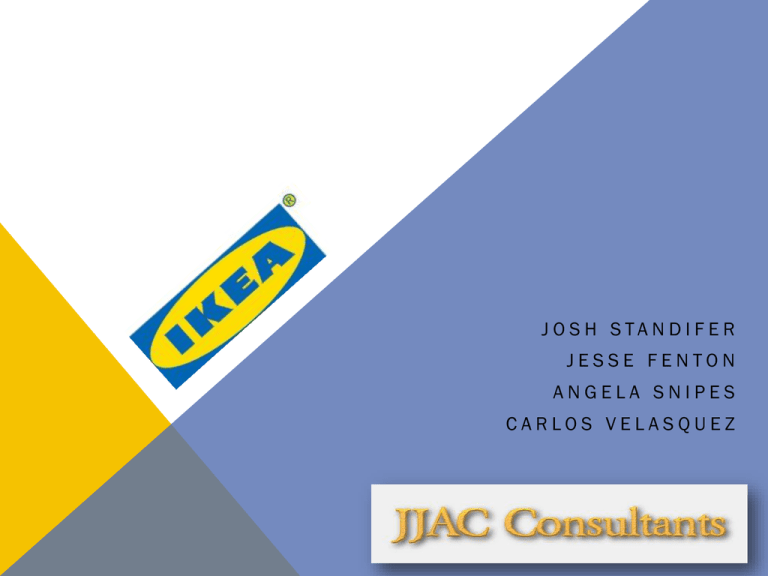
J O S H STA N D I F E R JESSE FENTON ANGELA SNIPES CARLOS VELASQUEZ OVERVIEW Background Big Problem Statement Issues Perspectives Knowledge / SWOT Actions / Consequences References Questions BACKGROUND • Founded 1933 by Ingvar Kamprad - Started as a mail order catalog - 338 total stores in 40 countries - 33 Global Distribution Centers - 6 North America - 13 stores opened during 2012 - 776 million visits to IKEA stores worldwide during FY’12 - 1.1 billion website visits during FY’12 - 212 million copies of the IKEA catalog were distributed worldwide last year PROBLEM The IKEA Distribution Center in Pooler, GA is state of the art. We feel that it could be even more efficient than it already is by implementing RFID (Radio Frequency Identification) technology and by upgrading the warehouse technology. ISSUES The new RFID technology and updated warehouse technology system will be costly up front. There will be employees that will not be happy about having to learn something new or change. SWOT MATRIX IKEA Strategy Map Technological Infrastructure Mission: To provide alternatives for IKEA warehouse technology Vision: To enhance business continuity and provide a disaster recovery plan for warehousing technology We will pursue our mission and vision through a focus on Quality, Safety and Value Service Excellence Customer Location Excellence Easing the exchange of information from the customer to the company Management Excellence Logistical transparency More accurate forecasting Measurements Leading – Can IKEA new technology prepare the company for better order tracking. Lagging – How many customers demand order tracking? Training and Development Prepare the management to overcome resistance to change, from lower level employees Expanding employee knowledge on technological acquisitions Training local employees on silo maintenance technology Educating, Training & Developing current employees on the new technology Financial Analysis To improve profitability and reduce costs while adding value so that the majority of consumers can purchase our product at lower prices. Decrease in expense of hiring/training workers Customer service efficiency Reduction in cost of maintenance by training employees Increasing profitability through supply chain efficiency Increasing visibility between the customer and the company with technological advancements RFID implementation Local silo replacements Customer/User interface enhancements Measurements Leading – Does the training of employees to new technology make IKEA more profitable? Lagging – How does Training help employees adapt to new technology ? Measurements Leading – Does the new technology provide cheaper alternatives for warehouse’s. Lagging – How much is profitability reduction cost ? Measurements Leading Indicators – Customers want to track orders Lagging – What is customer response after new technology has been implemented? ACTIONS JAAC Consultants recommends that IKEA let them do a financial analysis on the short term and long term cost and profit analysis. We believe that by implementing the RFID technology and integrating the SILO technology with the RFID and the customer user interface, we can not only lower IKEA’s operating cost, but we can also provide better customer service. With RFID technology we will always know where a package or a pallet is. QUESTIONS?

